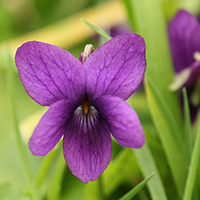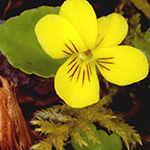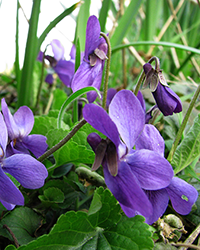Sweet Violet
Viola odorata
Violaceae

the plant: There are over 100 species in the Viola genus found across the continent, many that can be considered medicinally, lots native to North America, and some endangered (as always, only harvest if you are Sure the regional ecology can support it!). We focus here on the non-native European Sweet Violet, the species commonly documented in traditional Western herbalism.
Viola odorata is a creeping evergreen perrenial with heart-shaped, simple toothed leaves with basal arrangement and  stems that rise up from an underground rhizomatic vine.
stems that rise up from an underground rhizomatic vine.
Violet habitat is moist & damp, like boggy shady meadows or beneath trees. These violets flower in early spring, sending up delicate stems each with a small five-petalled flower that ranges from deep-purples and dark indigos to white. Violet nectar is beloved by bees & butterflies.
parts used: leaf and flower
medicinal actions: cooling demulcent, nutritive, alterative, expectorant, anti-inflammatory
below: Viola sempervirens,
local
native redwood violet
preparation: fresh leaf & flower as food; cold infusion of flowers; hot tea infusion; tincture; flower syrup, candied flowers.
indications: Violet is a gentle, moist and cooling remedy that soothes inflamed mucosa. It has been used traditionally as a cough remedy, especially for children and dry coughs. Violet leaves and flowers are a demulcent, nutritive and tasty food rich in minerals like Vitamins A & C, and can be eaten fresh or taken in tea.
Violet is a gentle, subtle remedy that can bring great relief.Herbalist Jim McDonald recommends violet - especially fresh - in the case of constitutional dryness - be it constipation, dry skin / mouth / breathing passages, dry cough, hard lymph nodes, or an herbal formula that is too dry. Violet is known to be a useful remedy for eczema, esepcially with children and elderly where gentleness is a must.
Violet also has the ability to act on the lymphatic sytem,  both topically as a poultice, and internally as tincture or tea. In the case of hot, swollen glands, or older, hard congested glands, it can bring releif and movement. It is known to be especially helpful with breast swellings, from mastitis to fybrocystic conditions, both internally and applied in oil with massage, and in combination perhaps with other herbs. Centuries ago violet was known to "ripen and dissolve swellings" and violet has a modern reputation for being useful in the treatment of cancer. Although this herb could be an appropriate part of a larger treatment approach, this 'anti-cancer' association is misleading in its oversimplification of the actions of an herbal medicine and the complexity of treating such a disease.
both topically as a poultice, and internally as tincture or tea. In the case of hot, swollen glands, or older, hard congested glands, it can bring releif and movement. It is known to be especially helpful with breast swellings, from mastitis to fybrocystic conditions, both internally and applied in oil with massage, and in combination perhaps with other herbs. Centuries ago violet was known to "ripen and dissolve swellings" and violet has a modern reputation for being useful in the treatment of cancer. Although this herb could be an appropriate part of a larger treatment approach, this 'anti-cancer' association is misleading in its oversimplification of the actions of an herbal medicine and the complexity of treating such a disease.
In the emotional, plant-spirit context, violet has been associated with love for centuries, and is said to 'calm and strengthen the heart' and soften and soothe the spirit, espeically in stress due to hot, dry rigidity of the emotions or psyche- not unlike the physiological use!
contraindications: Caution with root/seeds, strong emetic and not advised for use.
primary references:
• McDonald, Jim: Violet Herb Guest Post for Methow Valley Herbs
• Henriette's Herbal / The Dispensatory of the United States of America, 1918
• Hoffmann, David. Medical Herbalism, Rochester, Vermont: Healing Arts Press, 2003
note: This information is not a replacement for a trained herbalist. Please consult your medical professional before treating yourself or others with this or any other herbal remedy.